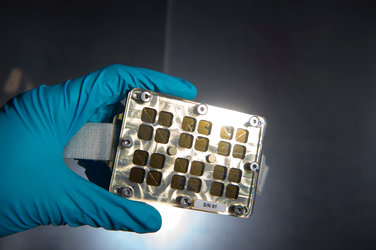Accept all cookies Accept only essential cookies See our Cookie Notice

About ESA
The European Space Agency (ESA) is Europe’s gateway to space. Its mission is to shape the development of Europe’s space capability and ensure that investment in space continues to deliver benefits to the citizens of Europe and the world.
Highlights
ESA - United space in Europe
This is ESA ESA facts Member States & Cooperating States Funding Director General Top management For Member State Delegations European vision European Space Policy ESA & EU Responsibility & Sustainability Annual Report Calendar of meetings Corporate newsEstablishments & sites
ESA Headquarters ESA ESTEC ESA ESOC ESA ESRIN ESA EAC ESA ESAC Europe's Spaceport ESA ESEC ESA ECSAT Brussels Office Washington OfficeWorking with ESA
Business with ESA ESA Commercialisation Gateway Law at ESA Careers Cyber resilience at ESA IT at ESA Newsroom Partnerships Merchandising Licence Education Open Space Innovation Platform Integrity and Reporting Administrative Tribunal Health and SafetyMore about ESA
History ESA Historical Archives Exhibitions Publications Art & Culture ESA Merchandise Kids Diversity ESA Brand Centre ESA ChampionsLatest
Space in Member States
Find out more about space activities in our 22 Member States, and understand how ESA works together with their national agencies, institutions and organisations.
Science & Exploration
Exploring our Solar System and unlocking the secrets of the Universe
Go to topicAstronauts
Missions
Juice Euclid Webb Solar Orbiter BepiColombo Gaia ExoMars Cheops Exoplanet missions More missionsActivities
International Space Station Orion service module Gateway Concordia Caves & Pangaea BenefitsLatest
Space Safety
Protecting life and infrastructure on Earth and in orbit
Go to topicAsteroids
Asteroids and Planetary Defence Asteroid danger explained Flyeye telescope: asteroid detection Hera mission: asteroid deflection Near-Earth Object Coordination CentreSpace junk
About space debris Space debris by the numbers Space Environment Report In space refuelling, refurbishing and removingSafety from space
Clean Space ecodesign Zero Debris Technologies Space for Earth Supporting Sustainable DevelopmentLatest
Applications
Using space to benefit citizens and meet future challenges on Earth
Go to topicObserving the Earth
Observing the Earth Future EO Copernicus Meteorology Space for our climate Satellite missionsCommercialisation
ESA Commercialisation Gateway Open Space Innovation Platform Business Incubation ESA Space SolutionsLatest
Enabling & Support
Making space accessible and developing the technologies for the future
Go to topicBuilding missions
Space Engineering and Technology Test centre Laboratories Concurrent Design Facility Preparing for the future Shaping the Future Discovery and Preparation Advanced Concepts TeamSpace transportation
Space Transportation Ariane Vega Space Rider Future space transportation Boost! Europe's Spaceport Launches from Europe's Spaceport from 2012Latest

Matiss-2 in Columbus
Thank you for liking
You have already liked this page, you can only like it once!
The Matiss-2 experiment was placed in Europe’s space laboratory Columbus for just under a year collecting dust and bacteria. Researchers will now analyse the surfaces to see which materials are least hospitable to unwanted bacteria – focusing on materials that expel water.
Everybody knows a clean house is a healthy place to live, but what if you live on the International Space Station? Air and water are constantly recycled and waste can only be removed when a spacecraft departs for Earth every few months. For the six astronauts living in humanity’s habitat in space, keeping the Station clean is an important part of their life to avoid bacteria and fungus. Every Saturday is cleaning day, when the whole crew wipe surfaces, vacuum and collect waste.
The Matiss experiment is investigating antibacterial properties of materials in space to see if future spacecraft could be made easier to clean.
The experiment consists of plaques placed in the European Columbus laboratory and leave for at least three months. France’s CNES space agency, in collaboration with the ENS University of Lyon, research institute CEA Tech - LETI and construction company Saint-Gobain, selected five advanced materials that could stop bacteria from settling and growing on the surface. A sixth element, made of glass, is used as control material.
The materials are a diverse mix of advanced technology – from self-assembly monolayers and green polymers to ceramic polymers and water-repellent hybrid silica. The smart materials should stop bacteria from sticking to the surface and growing, effectively making them easier to clean and more hygienic – but which one works best?
The units are open on the sides to let air flow naturally through and collect any bacteria floating past.
The Matiss-2 experiment returned to Earth for analysis on 27 August 2019 inside a Dragon spacecraft.
-
CREDIT
ESA/NASA -
LICENCE
ESA Standard Licence

Matiss-2 experiment on the Space Station

Matiss

Keep this surface dirty

Clean house















 Germany
Germany
 Austria
Austria
 Belgium
Belgium
 Denmark
Denmark
 Spain
Spain
 Estonia
Estonia
 Finland
Finland
 France
France
 Greece
Greece
 Hungary
Hungary
 Ireland
Ireland
 Italy
Italy
 Luxembourg
Luxembourg
 Norway
Norway
 The Netherlands
The Netherlands
 Poland
Poland
 Portugal
Portugal
 Czechia
Czechia
 Romania
Romania
 United Kingdom
United Kingdom
 Sweden
Sweden
 Switzerland
Switzerland






















